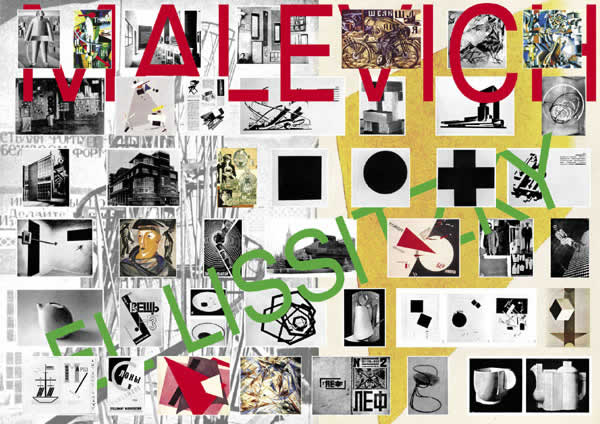so
much in these inconclusive works, although some of them are undoubtedly
'abstract', as in the theory which lay behind them and which rationalized
the contemporary ideas in Russia, carrying to their logical conclusion
Fauvism, Cubism and the indigenous Russian Decorative-Primitive movement:
it was based on this rationalization that Malevich went on to found Suprematism,
the first systematic school of abstract painting in the modern movement.
Larionov's Rayonnist works, however, differ profoundly from those
by Goncharova.. His are theoretical experiments, an objective analysis
worked in muted colours (Plates
76-79). Hers are closer, both
in subject and feeling to the Italian Futurists. While Larionov's subjects
are mostly still-lifes or portraits, Goncharova uses such titles as: The
Cyclist, The Factory, The Electrical Ornament or
The Machine's Engine (Plates
XX, 82). Her colour
is brilliant: blues, blacks and yellows predominate. The sensations of
speed and machine animation are her concern, rather than the objective
analysis of the abstract qualities of colour and line which Larionov proposed
in his manifesto of 1913.
Malevich first came in contact with Larionov's group when he exhibited
three works at the 'Knave of Diamonds' exhibition of 1910. It was the
beginning of a dramatic association.
KASIMIR
MALEVICH
* Malevich was born
near Kiev in 1878. He came of humble Polish-Russian stock. His father
was a foreman in a sugar factory in Kiev; his mother, a simple affectionate
woman, probably illiterate, was a close and constant companion to her
son; she lived with Malevich until she died in 1929 at the age of ninety-six.
Malevich received little education as a boy, but through his extraordinary
perseverence and remarkable intuitive intelligence he gained a wide background
of knowledge. Besides being an avid reader, he worked with great speed
and concentration, in a typically Russian fashion, ruthlessly pursuing
an idea to its logical conclusion. His many writings, which have an almost
patriarchal tone, do, however, bear the signs of his unsystematic education
in their confused thought and language. His simple background was probably
an additional barrier between Malevich and Kandinsky, a man of sophistication
and cosmopolitan upbringing; but although in life these artists made no
contact, in ideas they have much in common and are both fundamentally
related to the Symbolist movement.
Malevich was a brilliant speaker and a man of great charm and humour.
Although reserved about himself and his personal feelings, he was vociferous
in the cause of art, both in public discussions and in private pamphlets
and manifestoes.
When he was nineteen Malevich entered the Kiev School of Art. In
1900 he left and began working on his own. ‘Impressionist' is how these
early works were described in Russia, but this is the manner of execution
rather than the principle of the works, for Malevich from the outset was
not concerned with nature or analysing his visual impressions, but with
man and his relation to the cosmos.
page128

top
haut
alto
topo
|
tanto
nesses trabalhos inconclusos, embora alguns deles sejam indubitavelmente
‘abstratos’, quanto na teoria que deixaram em sua esteira
e que racionalizou as idéias contemporâneas na Rússia,
conduzindo à sua conclusão lógica o fauvismo, o cubismo
e o movimento nativo decorativo-primitivo russo: foi baseado nessa racionalização
que Malevich então descobriu o suprematismo, a primeira escola
sistemática de pintura abstrata do movimento moderno.
Os trabalhos raístas de Larionov, no entanto,
diferem profundamente dos de Goncharova. Os seus são experiências
teóricas, uma análise objetiva trabalhada em cores suaves
(Pranchas 76-79). Os dela estão mais próximos dos
futuristas italianos, tanto no assunto quanto na sensibilidade. Enquanto
os temas de Larionov são principalmente naturezas-mortas ou retratos,
Goncharova usa títulos como: O Ciclista, A Fábrica,
O Ornamento Elétrico ou O Mecanismo da Máquina
(Pranchas XX, 82). Seu cromatismo é brilhante: azuis,
pretos e amarelos predominam. As sensações de velocidade
e de movimentação de máquinas são sua preocupação,
mais do que a análise objetiva das qualidades abstratas da cor
e da linha que Larionov propôs em seu manifesto de 1913.
Malevich travou seu primeiro contato com o grupo de
Larionov quando exibiu três trabalhos na exposição
do ‘Valete de Ouros ‘ de 1910. Era o começo de uma
associação dramática.
KASIMIR MALEVICH
* Malevich nasceu perto de Kiev, em 1878. Provinha de humilde
ascendência russo-polonesa. O pai era capataz em uma fábrica
de açúcar em Kiev; a mãe, mulher simples e afetuosa,
provavelmente analfabeta, foi uma companheira íntima e constante
de seu filho, com quem morou até a morte, em 1929, aos noventa
e seis anos de idade. Malevich recebeu pouca instrução enquanto
menino mas, através de sua extraordinária perseverança
e notável inteligência intuitiva, adquiriu um amplo cabedal
de conhecimentos. Além de ser um ávido leitor, trabalhava
com grande velocidade e concentração, num estilo típicamente
russo, perseguindo implacavelmente uma idéia até a sua conclusão
lógica. Seus muitos escritos possuem um tom quase patriarcal que
ostentam, no entanto, os sinais da formação assistemática
em seus pensamentos e linguagem confusos. A sua origem humilde era provavelmente
uma barreira adicional entre Malevich e Kandinsky, um homem de sofisticação
e educação cosmopolita, mas embora em vida esses artistas
não houvessem estabelecido nenhum contato, tinham, nas idéias,
muito em comum, estando ambos, fundamentalmente relacionados com o movimento
simbolista.
Malevich era orador brilhante e um homem de grande charme
e humor. Embora reservado sobre si e seus sentimentos pessoais, ele era
vociferante na causa da arte, seja em discussões públicas
seja em manifestos e panfletos pessoais.
Aos dezenove anos, Malevich entrou na Escola de Arte de Kiev, que, em
1900, abandonou, começando a trabalhar por conta própria.
‘Impressionistas’ é como esses trabalhos iniciais foram
descritos na Rússia, numa referência mais ao modo de execução
do que ao princípio destas obras, pois Malevich desde o início
não se preocupava com a natureza ou com analisar suas impressões
visuais, mas com o homem e a relação deste com o cosmos.
página 128 |
